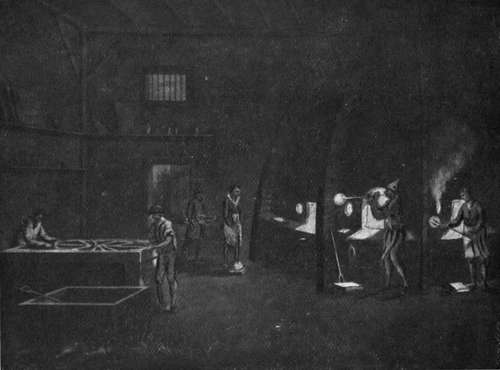Chapter I. History
Description
This section is from the book "Glass And Glass Manufacture", by Percival Marson. Also available from Amazon: Glass and Glass Manufacture.
Chapter I. History
The discovery of making glass is attributed to the early Phoenicians. Pliny states that certain mariners who had a cargo of sada salt, having landed on the banks of a river in Palestine, started a fire to cook their food, and, finding no stones to rest their pots on, they placed under them some lumps of the soda from their cargo. They found that the heat of their fire had melted the soda and fused it with the sand of the river bank, producing a transparent glass. The natives in the vicinity where this discovery was made took it up, and in process of time carried on the practice of fusing sand with soda and other materials to make glass, until they succeeded in improving and bringing the art to a much higher degree of excellence. Discoveries amongst the ruins of Pompeii and Herculaneum present some first-rate examples of the skill attained by the ancients in glass-making: glass was found to have been used there, admitting light into dwellings in the form of window glass.
The ancient Egyptians have left us many distinct proofs that glassmaking was practised in Egypt. At the same time, the glazing of pottery was also carried out, proving that they knew the mode of mixing, fusing, and melting the proper ingredients for glass-making. Among the tombs of Thebes many specimens of glass and glazed pottery beads have been found, which suggests a date about 3,500 years ago.
From the Egyptians, the Greeks and Romans acquired the art of glassmaking, which in Nero's time was so highly developed that- clear crystal glasses were produced in the form of drinking cups and goblets, which superseded the use of gold cups and were much prized by the Emperor in those days.
Many specimens of old Roman glass discovered have been preserved in the British Museum, and, although many valuable pieces have been lost by disintegration and collapse due to the influence of years of exposure, there still remain some very fine examples which show that the Romans were highly skilled in glass-making. One of the finest examples of the work of the ancient Romans in glassmaking is the Portland Vase, which was unearthed near Rome. This is an ornamented vase showing white opaque figures upon a dark blue background. The white opal appears to have been originally cased all over the blue and the beautiful figures carved out in cameo fashion, with astonishing patience and skill upon the part of the operator.
The Venetians and Muranians followed the Romans in the art, and examples of old Venetian glassware show rare skill and ingenuity. To the Venetians belongs the honour of first making glass at a cost to allow of its being more generally used, and they also introduced the art of making window glass and drinking vessels into this country. Jacob Verzelina, a Venetian, introduced such glassmaking into England, working at a factory in Crutched Friars, London, between 1550 and 1557, where he made window glass, afterwards carrying on similar work in other places about the country until his death in 1606.
Not until 1619 were glass works started in the neighbourhood of Stourbridge. There we find some remains of a factory worked by Tyzack about that date in making window glass in the village of Oldswinford. That Stourbridge should have been selected as one of the early centres for glassmaking is probably due to the presence in that locality of the fire-clay so necessary and important to glass manufacturers in building their furnaces and pots, and the coal used for maintaining the fires for melting their glass.
Stourbridge was known for a long time before this as a centre for the mines producing fire-clay, and eventually this clay was adopted for making glass-house pots; now many other sources are available for these fireclays. Much of the antiquity of the glassmaking of England is hidden in the neighbourhood of Stourbridge, and the writer has himself found a few antique specimens of old green devitrified window glass embedded in the subsoil of some fields near Oldswinford, probably relics of the Huguenots, who practised and extended the art of glassmaking in that district. Other important centres for glassmaking now are Yorkshire, London, Manchester, Edinburgh, Newcastle, and Birmingham; but, although glassmaking has reached a high degree of excellence in this country, there is nothing yet comparable with the extensive factories which exist abroad. The conservatism of many English manufacturers, and the adverse influence of the Glass Makers' Society, considerably restrict the progress of this trade compared with the broad and progressive manner in which it is carried on abroad.1

An Old Glass House, A.D. 1790
1 See article " Trade Unionism," in last chapter.
Continue to:
Tags
glass, manufacturing technology, furnace, glassware, wine glass
